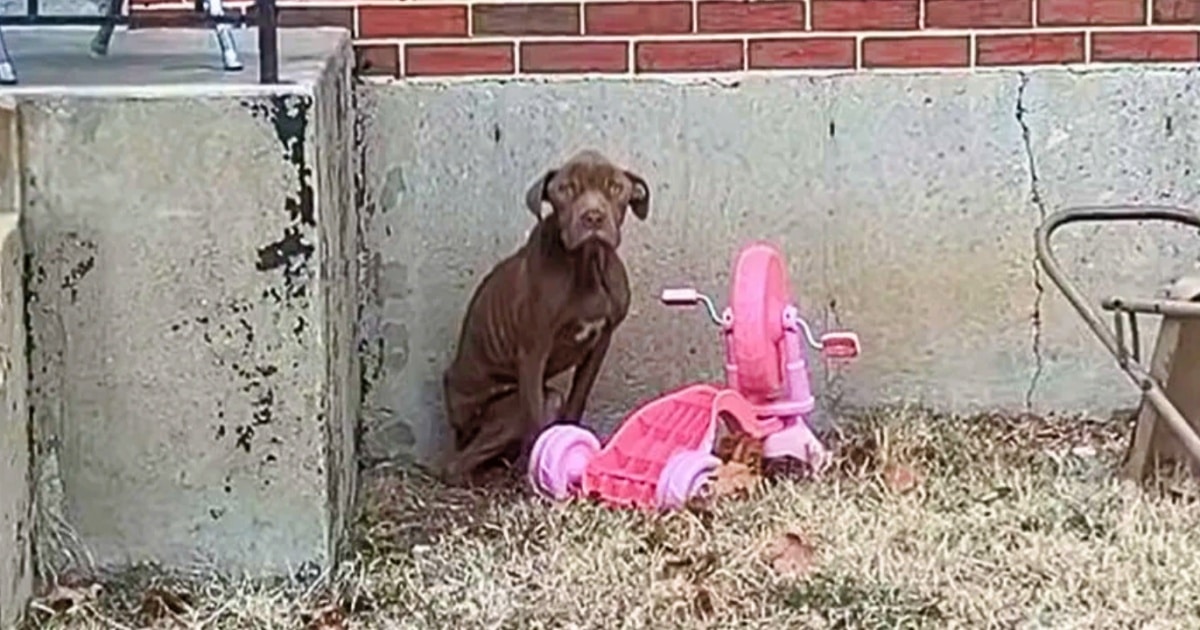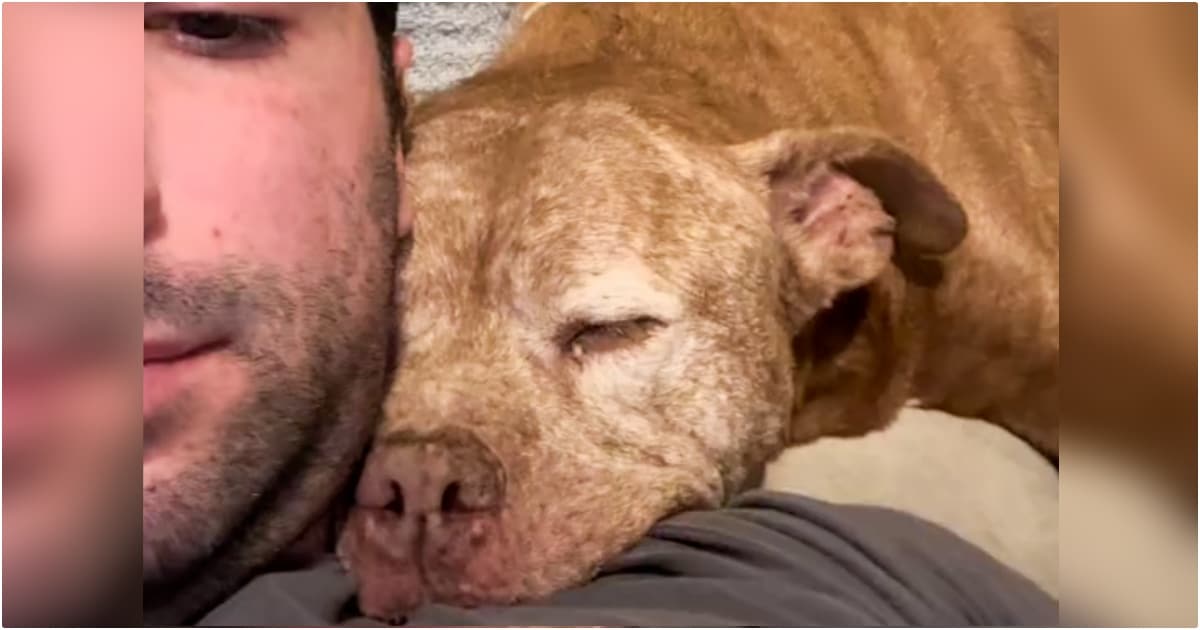
Dog shelters serve as crucial sanctuaries offering basic care and safety for animals in need, but they are not ideal as long-term homes for pets. The environment in many shelters can be overwhelming, filled with continuous barking and a generally chaotic atmosphere, which can be particularly stressful for dogs that are used to quieter, more stable home environments. The bare, minimally furnished kennels further exacerbate the feeling of displacement these animals experience, making the transition even more difficult.
This was certainly the case for Carson, a sweet-natured Pit Bull who was reluctantly abandoned at a local shelter when his family could no longer care for him. Despite his gentle disposition and his ability to charm those around him, Carson struggled significantly with the adjustment to shelter life. He had some allergies that caused skin issues, which likely became more pronounced due to stress. In the shelter, Carson often appeared distressed; he would huddle in the corner of his kennel, trembling and visibly in need of comfort—a sight that tugged at the heartstrings of anyone who witnessed his plight.
Carson’s story underscores the crucial need for understanding and addressing the unique needs and sensitivities of each dog, especially those in shelter environments. It serves as a poignant reminder of the importance of striving for a world where every dog can live in a loving home that meets their emotional and physical needs. His case highlights not just the resilience required to endure such hardships but also the profound difference that compassionate care and a suitable living environment can make in the life of a shelter animal.
Lauren, a dedicated volunteer with Philly Bully Team, was informed about Carson’s situation and made the compassionate choice to rescue him from the shelter, providing him with a loving home environment. Recognizing that a dog like Carson needed a sense of security to truly thrive, Lauren’s commitment to his well-being was evident from the start. Carson’s gratitude was palpable, and he quickly formed a deep bond with his savior. Wherever Lauren went, Carson was right by her side, demonstrating the strong connection they shared. Lauren understood the importance of providing Carson with constant attention, and she ensured that he received the care and companionship he desperately needed. Together, they were the perfect match, offering Carson the stability and love he deserved.
Lauren also knew they were a match made in heaven, and she informed the rescue group that she wanted to make the adoption final. They agreed. Carson is overjoyed to be reunited with Lauren that he won’t allow her out of his sight. It’s really endearing when you think about it, except when she has to get stuff done, like working from home. A 60-pound dog on your lap can be obstructive. Lauren, on the other hand, is such a good sport!
Stanley’s immediate connection with his new family, including the children and other pets, highlights the often remarkable adaptability and loving nature of rescue dogs. His seamless integration into the household underscores not only his friendly and gentle demeanor but also the compatibility and warmth that Golden Retrievers are known for.
The fact that Stanley bonded so quickly and effortlessly with everyone in the family reaffirmed their decision to welcome him into their home, despite any initial reservations about his peculiar habits. It became clear that his unique quirks were not obstacles but endearing traits that enhanced his personality and made him even more lovable.
Stanley’s story is a beautiful reminder of the joy and fulfillment that adopting a rescue dog can bring to a family. His quirks, rather than detracting from his appeal, have made him a distinctive and cherished member of the family, adding richness and depth to the family dynamic. This narrative exemplifies the positive outcomes that can arise from opening one’s home and heart to a rescue animal, demonstrating the mutual benefits of love and acceptance between humans and their furry companions.
Stanley’s unconventional behavior of climbing onto counters and tables, while endearing, understandably caused concern for his new family. Recognizing the potential risks such behaviors posed, his parents were proactive in seeking solutions to ensure his safety without stifling his curiosity and playfulness.
The family embarked on a journey of tailored training, adapting techniques that could help redirect Stanley’s exploratory habits in a safe manner. They consulted with dog training experts who had experience with similar behaviors and searched for resources that could provide guidance tailored to Stanley’s specific needs. This might include training that reinforces commands like “off” or “down” with positive reinforcement, or even redesigning certain home spaces to discourage unsafe climbing.
Furthermore, the family explored ways to enrich Stanley’s environment to satisfy his curiosity safely. This could involve providing alternative climbing opportunities that were secure and designated play areas where he could explore without the risk of injury. By doing so, they aimed to channel his natural instincts and energies into safer outlets.
Stanley’s story highlights the importance of understanding and adapting to the individual needs of each pet. His family’s dedication to ensuring his well-being, while nurturing his unique personality, underscores the commitment required to successfully integrate a rescue dog into one’s life. By prioritizing Stanley’s safety and emotional health, they not only prevented potential injuries but also ensured that he remained a happy, integral part of their loving home.
Stanley’s seemingly indifferent behavior toward his name and his peculiar daily rituals raised concerns and curiosity within his family. Their dedication to understanding him led them to observe and document his behaviors more closely, revealing patterns that suggested more than just quirky habits. Stanley’s routine of collecting specific items and arranging them meticulously pointed toward possible obsessive-compulsive behaviors, which are not uncommon in dogs but often misunderstood.
Realizing that standard training methods were not effective, and given the previous trainers’ challenges and suggestions about Stanley’s mental capabilities, the family decided to delve deeper into understanding canine cognitive and psychological health. This commitment led them to consult with animal behaviorists and veterinarians who specialized in neurodiversity and mental health in pets.
These experts helped the family to understand that Stanley’s behaviors might be manifestations of anxiety or a way for him to exert control over his environment, which can be common in animals that have experienced past trauma or instability. With professional guidance, the family learned strategies tailored specifically to Stanley’s needs, which included structured routines to provide him with a sense of security, environmental enrichment activities to keep his mind engaged, and gentle, consistent training techniques to reinforce desired behaviors without causing stress.
By approaching Stanley’s care with empathy and a willingness to adapt to his unique needs, the family not only fostered a deeper bond with him but also created an environment where Stanley could thrive despite his challenges. This approach not only ensured Stanley’s well-being but also highlighted the importance of compassion and persistence in caring for pets with special behavioral needs.

Lauren, a dedicated volunteer with Philly Bully Team, was informed about Carson’s situation and made the compassionate choice to rescue him from the shelter, providing him with a loving home environment. Recognizing that a dog like Carson needed a sense of security to truly thrive, Lauren’s commitment to his well-being was evident from the start. Carson’s gratitude was palpable, and he quickly formed a deep bond with his savior. Wherever Lauren went, Carson was right by her side, demonstrating the strong connection they shared. Lauren understood the importance of providing Carson with constant attention, and she ensured that he received the care and companionship he desperately needed. Together, they were the perfect match, offering Carson the stability and love he deserved.

Lauren also knew they were a match made in heaven, and she informed the rescue group that she wanted to make the adoption final. They agreed. Carson is overjoyed to be reunited with Lauren that he won’t allow her out of his sight. It’s really endearing when you think about it, except when she has to get stuff done, like working from home. A 60-pound dog on your lap can be obstructive. Lauren, on the other hand, is such a good sport!
Learn More About the Pit Bull Dog Breed: Information, Facts & Pictures

Snuggling, on the other hand, is Carson’s favorite pastime. He likes to go for walks and seek out the best sticks. He enjoys walking with a stick in his mouth. According to Lauren, “his entire body wags.” It’s lovely to see a dog go from shaking and terrified to a happy boy. When Carson comes home after his walks, he jumps on the sofa and gives the greatest tail wags you’ve ever seen. All you can hear are the swishing of his delighted tail as it hits the ground.
His mother, Lauren, says in the video below that:
“His mission in life is to curl up on the couch with me.” Sounds like Carson has some clear priorities!













































